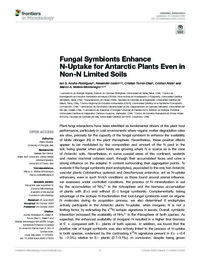Mostrar el registro sencillo de la publicación
Fungal symbionts enhance N-uptake for Antarctic plants even in non-N limited soils
| dc.contributor.author | Acuña-Rodríguez, Ian S. | |
| dc.contributor.author | Galán, Alexander | |
| dc.contributor.author | Torres-Díaz, Cristian | |
| dc.contributor.author | Atala, Cristian | |
| dc.contributor.author | Molina-Montenegro, Marco A. | |
| dc.date.accessioned | 2020-12-11T19:26:52Z | |
| dc.date.available | 2020-12-11T19:26:52Z | |
| dc.date.issued | 2020 | |
| dc.identifier.uri | http://repositorio.ucm.cl/handle/ucm/3354 | |
| dc.description.abstract | Plant-fungi interactions have been identified as fundamental drivers of the plant host performance, particularly in cold environments where organic matter degradation rates are slow, precisely for the capacity of the fungal symbiont to enhance the availability of labile nitrogen (N) in the plant rhizosphere. Nevertheless, these positive effects appear to be modulated by the composition and amount of the N pool in the soil, being greater when plant hosts are growing where N is scarce as is the case of Antarctic soils. Nevertheless, in some coastal areas of this continent, seabirds and marine mammal colonies exert, through their accumulated feces and urine a strong influence on the edaphic N content surrounding their aggregation points. To evaluate if the fungal symbionts (root endophytes), associated to the only two Antarctic vascular plants Colobanthus quitensis and Deschampsia antarctica, act as N-uptake enhancers, even in such N-rich conditions as those found around animal influence, we assessed, under controlled conditions, the process of N mineralization in soil by the accumulation of NH4+ in the rizhosphere and the biomass accumulation of plants with (E+) and without (E−) fungal symbionts. Complementarily, taking advantage of the isotopic N-fractionation that root-fungal symbionts exert on organic N molecules during its acquisition process, we also determined if endophytes actively participate in the Antarctic plants N-uptake, when inorganic N is not a limiting factor, by estimating the δ15N isotopic signatures in leaves. Overall, symbiotic interaction increased the availability of NH4+ in the rhizosphere of both species. As expected, the enhanced availability of inorganic N resulted in a higher final biomass in E + compared with E− plants of both species. In addition, we found that the positive role of fungal symbionts was also actively linked to the process of N-uptake in both species, evidenced by the contrasting δ15N signatures present in E+ (−0.4 to −2.3‰) relative to E− plants (2.7–3.1‰). In conclusion, despite being grown under rich N soils, the two Antarctic vascular plants showed that the presence of root-fungal endophytes, furthermore enhanced the availability of inorganic N sources in the rhizosphere, has a positive impact in their biomass, remarking the active participation of these endophytes in the N-uptake process for plants inhabiting the Antarctic continent. | es_CL |
| dc.language.iso | en | es_CL |
| dc.rights | Atribución-NoComercial-SinDerivadas 3.0 Chile | * |
| dc.rights.uri | http://creativecommons.org/licenses/by-nc-nd/3.0/cl/ | * |
| dc.source | Frontiers in Microbiology, 11, 575563 | es_CL |
| dc.subject | Plant-fungi interactions | es_CL |
| dc.subject | Nitrogen | es_CL |
| dc.subject | Endophytes | es_CL |
| dc.subject | Antarctic vascular plants | es_CL |
| dc.subject | Ornithogenic soils | es_CL |
| dc.title | Fungal symbionts enhance N-uptake for Antarctic plants even in non-N limited soils | es_CL |
| dc.type | Article | es_CL |
| dc.ucm.indexacion | Scopus | es_CL |
| dc.ucm.indexacion | Isi | es_CL |
| dc.ucm.doi | doi.org/10.3389/fmicb.2020.575563 | es_CL |



